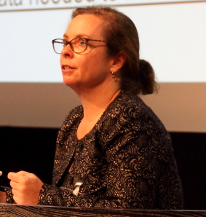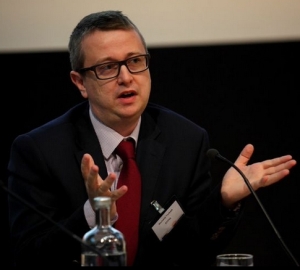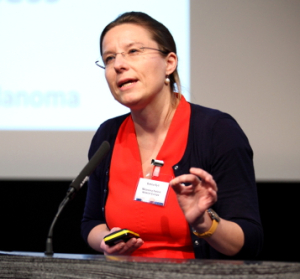Conference Report: Better Science, Better Health: New Trial Pathways and Better Patient Data
A report of an international conference held at the Royal College of Physicians, London, 21 October 2014
New Pathways for Development and Better Patient Outcomes
On October 21st, an international group of experts was invited to the Royal College of Physicians in London to discuss how new clinical regulatory pathways, sources of evidence, and evolving data on real world patients can be used both to expedite the development of drugs and improve their quality and access. Broadly called “MAPPs” (Medicines Adaptive Pathways to Patients), the goal is to speed patient access to needed therapies while increasing the productivity of industry R&D spending.
It is a major opportunity for governments to spend every £1 going into healthcare more smartly, said George Freeman, UK life Sciences Minister, in his opening address to the conference. There is a need to shift the centre of gravity of pharmaceutical R&D, “so that we are designing drugs around patients,” Freeman said.
Using early access and adaptive licensing to achieve this reshaping of drug development “will take time and money out of the system,” Freeman told delegates.
In April the UK set up a special programme, the Early Access to Medicines Scheme (EAMS) to speed development of new treatments in areas of high unmet medical need. The first product to be accepted into the scheme is a vaccine for treating brain cancer.
In parallel, the European Medicines Agency (EMA) opened a pilot project in adaptive licensing in March and has since received 29 applications. The intention in the pilot is to expedite products through to early authorisation in a defined patient population and then have iterative phases of real world evidence gathering, allowing the marketing authorisation to be adapted, and to expand to broader patient populations.
Hans-Georg Eichler, Senior Medical Officer at the EMA told delegates the agency is pleased with the response. However, he encouraged the utilisation of greater “creative intelligence”. The use of safe harbour allows applicants to discuss in confidence their objectives, and the pilot should make it possible to inject adaptive approaches and designs into the pathways. However, most of the applications, “are still talking in a linear way, of going from A to B to C,” said Eichler.
Tools are needed to stimulate thinking in designing non linear pathways. “It’s more difficult than you would think,” Eichler added.
Using adaptive pathways to try and go faster will inevitably create greater uncertainty. This is undoubtedly the case for patients, because although drugs will have been tested for safety and have shown some evidence of efficacy, the overall data file will be based on a smaller population than in conventional clinical studies.
The uncertainty also extends to payers, because adaptive approaches imply an ongoing process of re-evaluation of a product, making it difficult to define value in terms of price, and also in understanding how many patients qualify for access, said Paolo Daniele Siviero, Head of Pharmaceutical Policy at the Italian Medicines Agency.
“To avoid exclusion or expenditure going out of control, managed entry agreements are good tools,” Siviero said. In addition, setting up patient registries will assist in defining price and access and help payers to understand, “where your investment in health will be most cost-effective,” he added.
Adaptive licensing has the potential to increase efficiency in drug development, constraining escalating costs, and the industry is committed to playing its part, said Stephen Whitehead, Chief Executive of the Association of the British Pharmaceutical Industry (ABPI). In the UK, EAMS will be particularly significant for SMEs, because money invested in R&D will not be tied up for so long. It will also allow developers to collect early evidence of value, alongside the generation of safety and efficacy data.
However, there are risks for the industry, with the absence of government funding to support EAMS “sending out the wrong signals,” whilst smaller trials will increase the risk of equivocal safety read outs which, “will need to be contextualised,” Whitehead said.
It is also important to note the National Health Service (NHS) in England is in a time of flux, presenting difficulties in creating real world evidence. “Data is critical: how will it be fed into pricing and reimbursement? What evidence will be needed? And who will collect it; the industry or the NHS?” Whitehead said.
As yet, there is not clear delineation between when a sponsor company stops providing a drug for free – as is the convention in a clinical trial – and starts to get paid. And if companies are to get the benefits of EAMS, the scheme must be aligned with the EMA adaptive licensing pilot, Whitehead noted.
Pharma is also putting its weight behind adaptive pathways at a European level, in the industry-driven Innovative Medicines Initiative (IMI). Research and development of tools and processes for improving patient access will be a key objective of its second €3 billion programme of research IMI 2, which will run from 2014 – 2024 as part of the European Union’s €80 billion Horizon 2020 R&D programme, said Michel Goldman, Executive Director of IMI.
The €2 billion IMI 1 has developed several tools and methods which will help with timely patient access. It has also prompted a change in mind-set, with industry seeing that academic scientists can appreciate and respond to its priorities, and academics understanding that working with industry can simultaneously increase the impact of their science, whilst promoting its translation into clinical care.
“Now we need more science, more research and a new kind of expertise to develop new pathways,” Goldman said. The aim in IMI 2 is to remove the boundary between clinical research and clinical practice, through a new approach to data generation and data collection.
New Pathways and New Sources of Evidence: What do we Need?
Whilst the stakeholders recognise the need to update the traditional drug development system and are combining their efforts to achieve reform, much work is required to scope and test new development pathways and to establish new approaches to data generation.
The Massachusetts Institute of Technology’s (MIT) NEWDIGS (New Drug Development Paradigms) programme is working to build a shared view of what evidence is needed to support the develop of new pathways, bringing all stakeholders together under safe harbour agreements to build relationships between multiple parties to push adaptive pathways forward.
Marc Trusheim of MIT Sloan School of Management and a NEWDIGS researcher, highlighted examples of some marketed drugs where an adaptive approach would have shown benefits. The cancer drug Zelborag[1] was in essence approved under an adaptive licensing pathway, following an abbreviated Phase III. This meant it was on the market two years earlier, adding 9,000 patient life years to the survival benefits the drug has delivered.
On the other hand, the multiple sclerosis drug Gilenya[2] reached the market before its potential to cause cardiovascular side effects came to light. “The Phase III didn’t detect it, it had to be seen in real world data,” Trusheim said. If Gilenya had been developed in an adaptive way, it would have reached the market sooner, benefiting patients and it would have taken 8,000 patient years for the cardiovascular risk to become evident. As it was, it took 16,000 patient exposure years for the risk to come to be evident.
In another example, the anti-obesity drug Acomplia[3] was approved by the EMA despite a known risk of it causing psychiatric side effects in people with depression. As many as 40 per cent of obese people also suffer depression, and a number were misprescribed Acomplia, causing side effects and leading the drug to be withdrawn.
As Trusheim noted, with improved data and feedback, it would have been possible to maintain more control over prescribing. “With improved control you could have an obesity drug that delivers value for those who benefit, but exclude those who can’t. You could have preserved value,” he said.
These examples underline how adaptive pathways must factor in the views on risks and benefit of all the stakeholders. “Patients are first, but no one is last. We all have to come out reasonably well,” Trusheim said. “Through adaptive licensing there’s a way to make everybody win.”
Setting down an adaptive pathway is not only a case of having all the stakeholders involved, it must also embrace the whole life cycle of a drug, said Finn Børlum Kristensen, Executive Director of EUnetHTA (European Network for Health Technology Assessment)
While traditionally, drug regulators work at specific time points, HTA bodies are accustomed to looking at life cycles. “You need to have the involvement of HTA to make adaptive licensing work,” Kristensen told delegates. Given this, HTAs would like companies to share more information from trials, and to get more information from the EMA about the regulatory deliberations. “This would help us in inferring the real life effects – which is different from efficacy,” Kristensen noted.
In parallel with carrying out health technology assessments, payers should also be asking HTAs to make a systems assessment of how a new medicine will change the care pathway. This involves data outside traditional drug discovery and development, related to issues including the organisation of care and societal impact.
Achieving such an overview will require the linking of data that currently is held in silos, in health insurance bodies, primary healthcare, hospital records and other databases, said Jillian Oderkirk, Senior Analyst, Health Division, OECD. “The older approach to clinical trials answers the question ‘Can it work?’, but we want to understand if it works with a complex patient in the real world, and if it is the best choice for that patient,” Oderkirk said.
Most OECD member countries have national data covering the key elements of care pathways, but because the databases are not linked, it is not possible to follow a whole pathway. “We need systems and governance to re-process and re-use data in an ethical way,” Oderkirk said.
The OECD is working on a set of recommendations to allow governments to maximise the value of health data, whilst minimising the risks around data privacy. “Getting the governance right is the key success factor,” said Oderkirk.
Adaptive pathways may require a new approach to clinical development, but there is already a level of flexibility built into the EMA regulatory system and it is not clear this is being used in the right way to make medicines available to patients sooner, said Olga Solomon, Deputy Head of Unit D5 Medicinal Products at DG Sanco, European Commission.
Examples include accelerated assessment, conditional approval and compassionate use exemptions. “The European Commission sees a need to address the question of how adaptive licensing fits into the current EU regulation framework,” Solomon said. While the scientific issues will be dealt with in the EMA’s adaptive licensing pilot project, the legal and policy issues have been under discussion by the 28 member states in the pharmaceutical committee since March 2014.
Member States are positive about the adaptive licensing pilot as a whole, however several questions are to be addressed regarding European-level harmonisation in areas that fall under national competence or additional burdens related to managing registries and prescriptions.
In addition, there is concern that in shifting the balance to post-authorisation, requiring the compilation of registries and controlling prescriptions, amongst other measures, adaptive licensing will create an additional burden for national regulatory agencies.
It is hard to have a conversation about healthcare without addressing sustainability while also simultaneously the need for technology to arrest increasing costs. But growth in healthcare expenditure is not bad if there is a return on the investment, as for example, under the US Affordable Care Act, which has brought more people under the umbrella of health insurance.
“We need better data to help ensure that health systems resources are spent in the best possible way” said Richard Torbett, Chief Economist of EFPIA (European Federation of Pharmaceutical Industries and Associations).
The industry is supportive of a value-based agenda because if implemented in the right, it way should help ensure that medicines adding most value are most rewarded. “The industry is interested in supporting the transition to a world where data is collected throughout the life cycle of a product,” Torbett said.
However, there needs to be better understanding of where these changes will take the industry in the long term. Some have argued that adaptive licensing may imply adaptive reimbursement and/or adaptive pricing. “Some payers have even signalled, in principle, support for the idea that if the value you can demonstrate with data changes over time, the price or reimbursement status of the medicine could reflect those changes. This means, for instance, for a medicine that expands the number of its indications through adaptive licensing, the price could go up as more value is demonstrated.”
However this is at odds with current global practise amongst payers, who expect better deals for purchasing higher volumes. The question of how to square the notion that the price goes up with more, better, data – but would be expected to come down with more indications and greater volumes, will be hard to resolve, said Torbett. “There are genuine unanswered questions about how it would work in practice.”
The Patient’s Understanding of Benefit Risk
Whatever future adaptive pathways look like, there is agreement they must be designed around patients. The patient contribution is particularly significant in relation to risk: patients know best what matters to them, what they can live with, and how important a particular intervention is.
Crucially, the view that someone with a life-limiting disease takes of risk is different from the perspective of other stakeholders. The question is, how to translate patients’ views in a tangible way that can inform action to get medicines to patients faster.
Pat Furlong, CEO of Patient Project Muscular Dystrophy, described generating benefit risk data in a bid to influence the FDA’s approach to assessing treatments that are starting to come through the pipeline for this inherited disease – with many products in development because the efforts of patients’ groups have led to a dramatic increase in R&D funding for muscular dystrophy.
Parents of boys with the condition strongly prioritise halting progression of this fatal disease and of ensuring their sons receive optimal care. After protracted lobbying, the FDA is now writing guidance on treating the disease.
The fundraising efforts of DMD patients’ groups mean a number of promising therapies are coming through development. But, said Furlong, this creates a dilemma, with participation in a clinical trial likely to take up to three years of a short life. “The pipeline is full of hope, but there is only one shot on goal,” she said.
The patient right to be involved in the assessment of benefit risks is heightened by the move to adaptive pathways, said Yann Le Cam, CEO of Eurordis (European Organisation for Rare Diseases). Adaptive pathways will lead to greater uncertainty. “There’s no way patients can’t be involved,” he said. The EMA’s recent decision to have two patients sitting on its Committee for Medicinal Products for Human Use (CHMP) represents a “major breakthrough” in this respect.
However, it can be difficult to find patients that know a disease well enough and are able to understand the discussions in the CHMP, articulate the arguments and speak in public. ”It’s hard work,” Le Cam said.
Sarah Garner of the UK health technology assessment body, NICE (National Institute for Health and Care Excellence), described NICE’s approach to getting the public’s view of risk and benefits through its Citizen’s Council, comprising 30 people who meet regularly. Among its deliberations, the Council has considered if there should be some form of social contract around drug development.
“All drugs have risks, so how do you manage that risk?” Garner asked. For now the jury is still out on whether adaptive licensing will be a revolution or an evolution in terms of its impact on patients and benefit risk, she said.
Andrea Beyer of the University of Groningen, an expert in benefit risk assessment, outlined research she has carried out under IMI 1 and in cooperation with the EMA, to develop a methodology to help patients understand and articulate benefit risk and translate this to the regulators.
In the example of multiple sclerosis, patients completed a survey in which they were asked to decide between three alternative treatments with different risk benefit profiles. The survey was in plain language and required only a simple response. Using this approach, “You can translate qualitative information into quantitative information and so decide what is the best treatment for each patient,” Beyer said.
The example of multiple sclerosis highlighted how perceptions of risk benefit vary with the severity of disease. Patients who were able to walk had different risk attitudes from patients who could not walk. This sort of analysis goes a step beyond patient reported outcomes, and could be flowed into current clinical trials, Beyer noted.
Bettina Ryll, founder of the Melanoma Patient Network, a medical doctor with a PhD in molecular biology, described how her perception of evidence-based medicine was transformed by the experience of her husband Peter – who has since died – taking part in a number of melanoma clinical trials.
Currently, Ryll noted, risk perception in clinical trials is slanted towards the people running the process. Patients should never receive inferior treatments or placebo to fulfil clinical trial criteria. Yet experimental melanoma drugs are trialled against control arms in which patients are treated with chemotherapy, which is known to be ineffective in melanoma.
This is clearly unethical. “Society must do drug development according to the risk perception of patients. Patients take the risks, they are the ones that pay if the trial design is wrong, if they are in the control arm, if one drug is inferior to another,” Ryll said.
Putting Medicines Adaptive Pathways to Patients (MAPPs) into Practice in Europe
While there is consensus on the need to update regulatory pathways in line with advances in science, there is confusion around the terminology, with labels including staggered approval, progressive licensing and adaptive licensing, often used interchangeably.
The broader concept of Medicines Adaptive Pathways to Patients (MAPPs), has been adopted as embracing all elements of the switch from basing marketing approvals on retrospective trials, to taking a prospective approach, in which a drug is approved in a niche indication and then brought into wider use on the basis of iterative phases of real world evidence gathering.
The final session of the conference discussed how to put MAPPs into practice in Europe, whilst bearing in mind that such a huge shift must encompass the whole life cycle of a product and factor in the global perspective.
The high level of collaboration in the Innovative Medicines Initiative will be instrumental in helping to break down silos and create shared understanding of the different perspectives of different stakeholders. “This is about getting the right treatments to the right patients at the right time: we can’t do things the same way as before and MAPPs really is on the agenda of IMI 2,” said Nathalie Seigneuret, Senior Science Project Manager, IMI.
“We need to understand where all the activities fit,” Seigneuret said. IMI will be launching an initiative in December to create an enabling platform for all the stakeholders, and looking to see where the gaps are, she said.
The industry is putting €1.5 billion of in-kind resources into IMI 2, to be matched by €1.5 billion of grant funding from the European Union. The Commission’s R&D Directorate considers it is important that MAPPs is part of IMI 2 said Cornelius Schmaltz, Deputy Head of Unit of the Fighting Infectious Diseases and Global Epidemics Unit of the European Commission. “We have a vital interest in MAPPs because the best research and innovation is relatively useless if it doesn’t get to patients,” he said.
IMI’s structure as a public/private partnership means it is ideally placed to drive MAPPs forward because it can bring in patients and regulatory agencies. “Patients need to be the cornerstone of the enterprise. We need to listen to them and take account of their views of risks and benefits,” Schmaltz said.
While the EMA adaptive licensing pilot is working within the framework of existing regulation, it will be important to pinpoint and specify where new regulation is needed. IMI is also the appropriate forum for strengthening research and filling in technical gaps, particularly in relation to the challenges of collecting real world data, Schmaltz added.
MAPPs is a vital component in assuring the sustainability of healthcare systems, but in order to inculcate an adaptive approach, everyone has to change their mind-set, said Richard Barker, Director of the Centre for the Advancement of Sustainable Medical Innovation (CASMI). “We are on the brink of a new era in drug development – if we take it seriously we are creating a new social contract. I am positive – but there are problems,” Barker said.
Obstacles include biomarker validation and adoption, the need for better data collection strategies and common data standards, a requirement for adaptive pricing and an economic model that works.
There must be patient engagement throughout the process not just around the table when an adaptive pathway is first mapped out.
MAPPs has its roots at the confluence of two opposing forces, where the traditional model of drug development meets the rise of genomics and personalised medicines, creating an impetus for change.
Jeremy Haigh, Chief Operating Officer of R&D Operations at Amgen Ltd reminded delegates that MAPPs is a broader concept than adaptive licensing. He sees a number of hurdles, including creating a process that can properly tap scientific innovation, breaking down barriers between silos and ensuring patients are meaningfully engaged. “MAPPs isn’t a theoretical exercise, it needs to be practical, and it will only work if patients are at the centre,” Haigh said.
Legislation and regulatory pathways are not keeping pace with scientific progress. “Regulation is used to limit innovation, whereas it ought to support it,” said Haigh. Meanwhile, “HTA does not reflect the total net benefit of new therapies.”
But the central difficulty is that implementing MAPPs requires all elements of the chain to be dealt with at the same time. “All stakeholders are aligned on the need for change, but their motivations may be different,” Haigh said.
In the end however, moving towards flexible pricing is critical. “Wherever you go in this debate, at some time you have got to come back to price,” said Haigh. “That’s the game-changer – unless that is right MAPPS won’t succeed.”
———————————-
[1] Baird, Trusheim et al. Comparison of Stakeholder Metrics for Traditional and Adaptive Development and Licensing Approaches to Drug Development, Therapeutic Innovation & Regulatory Science, 47(4):474-483 (May 2013).
[2] Ibid.
[3] Ibid.











